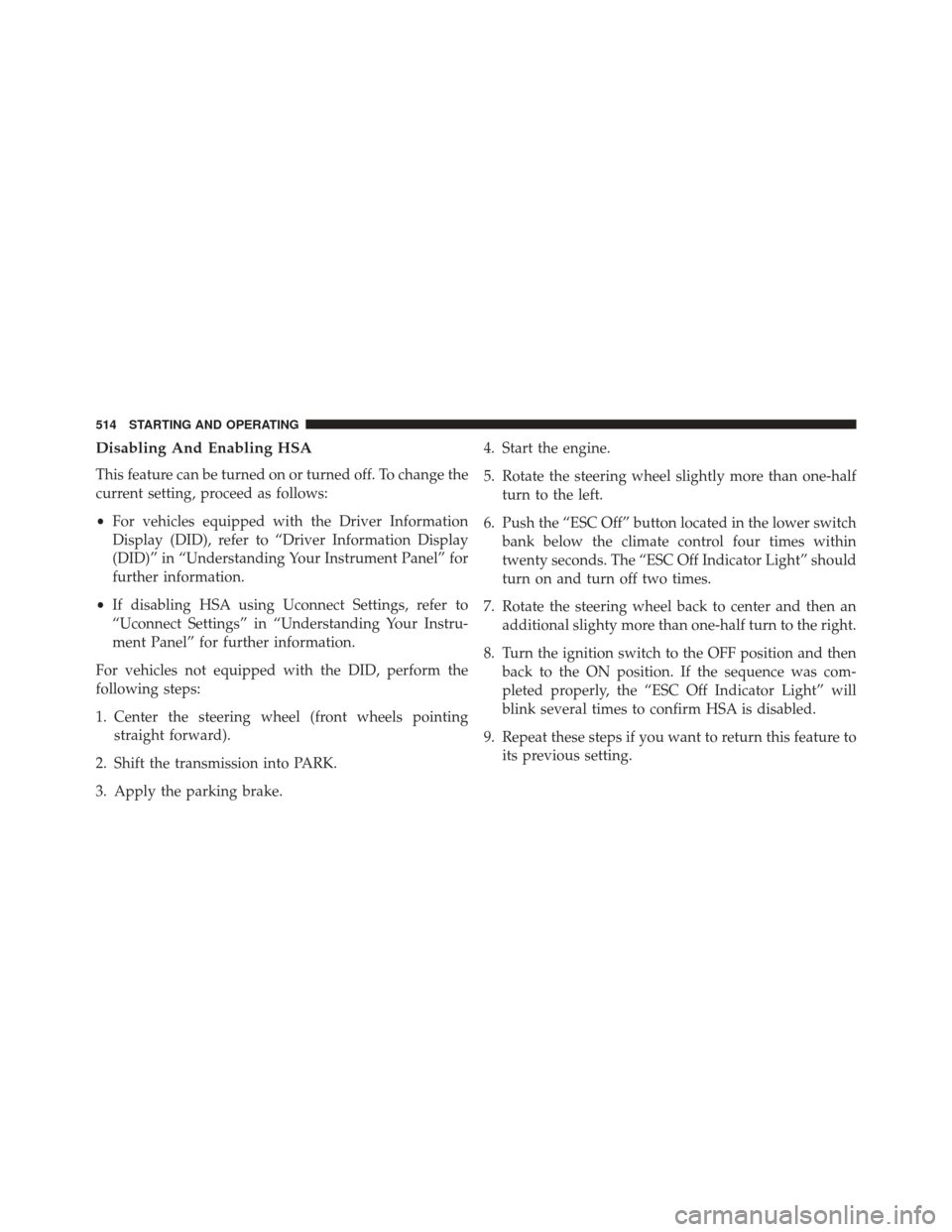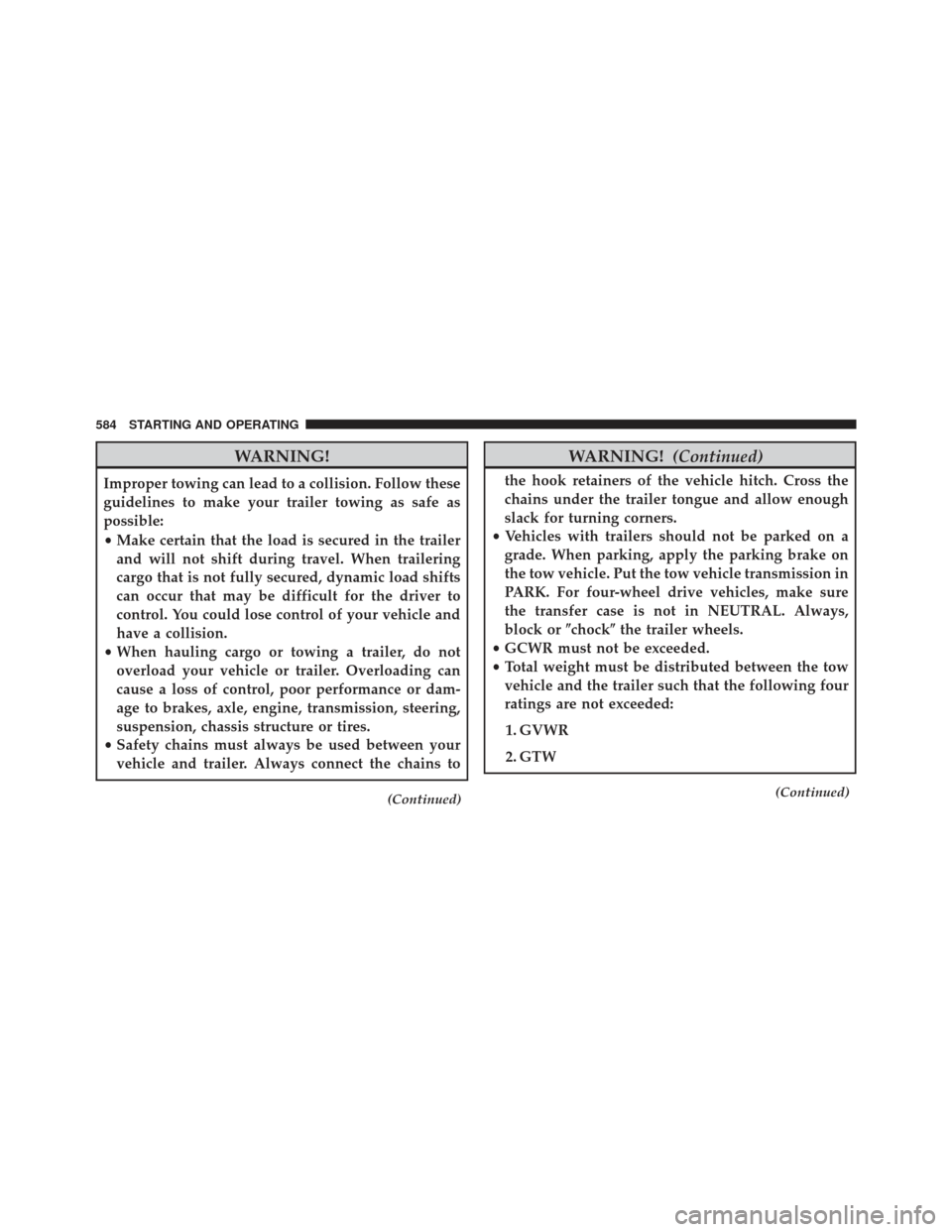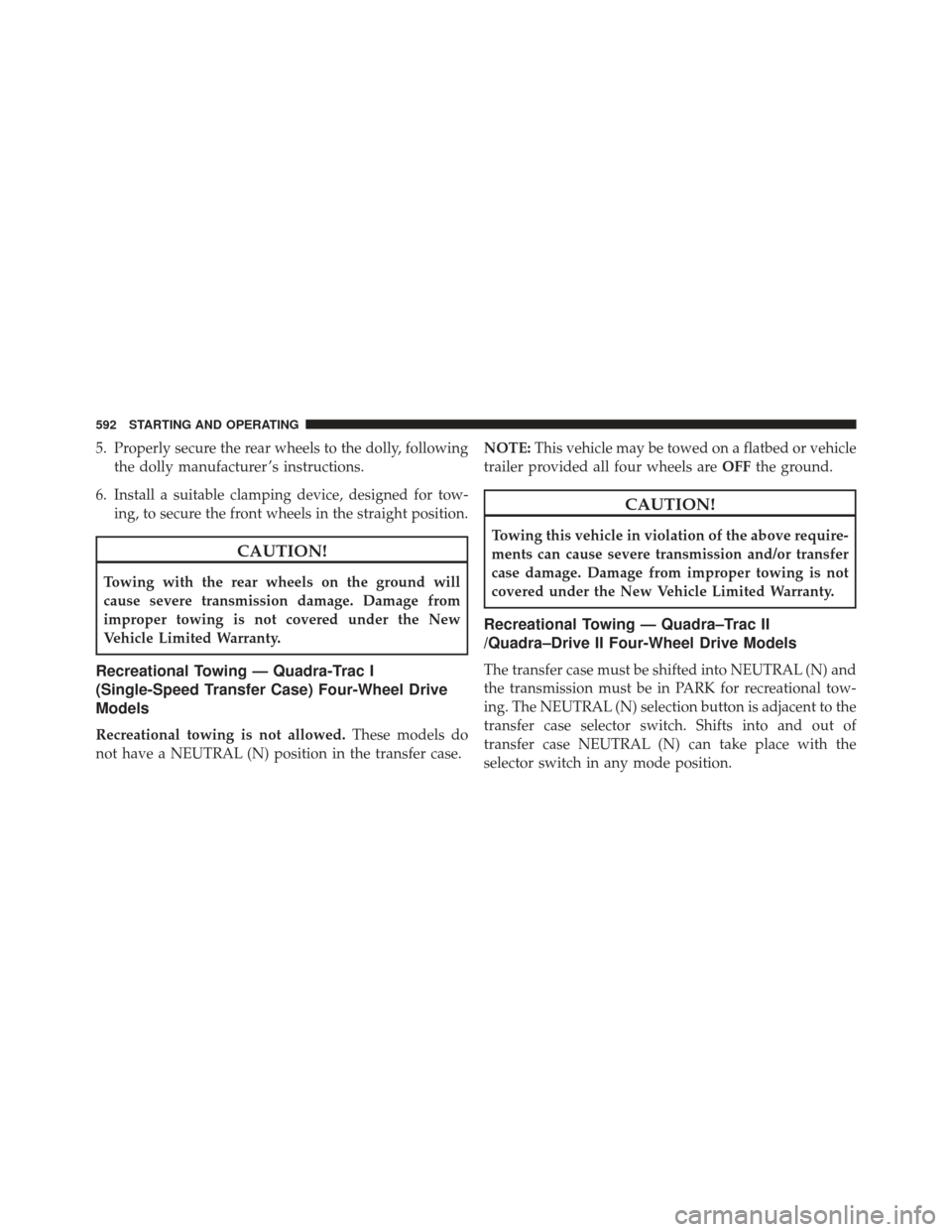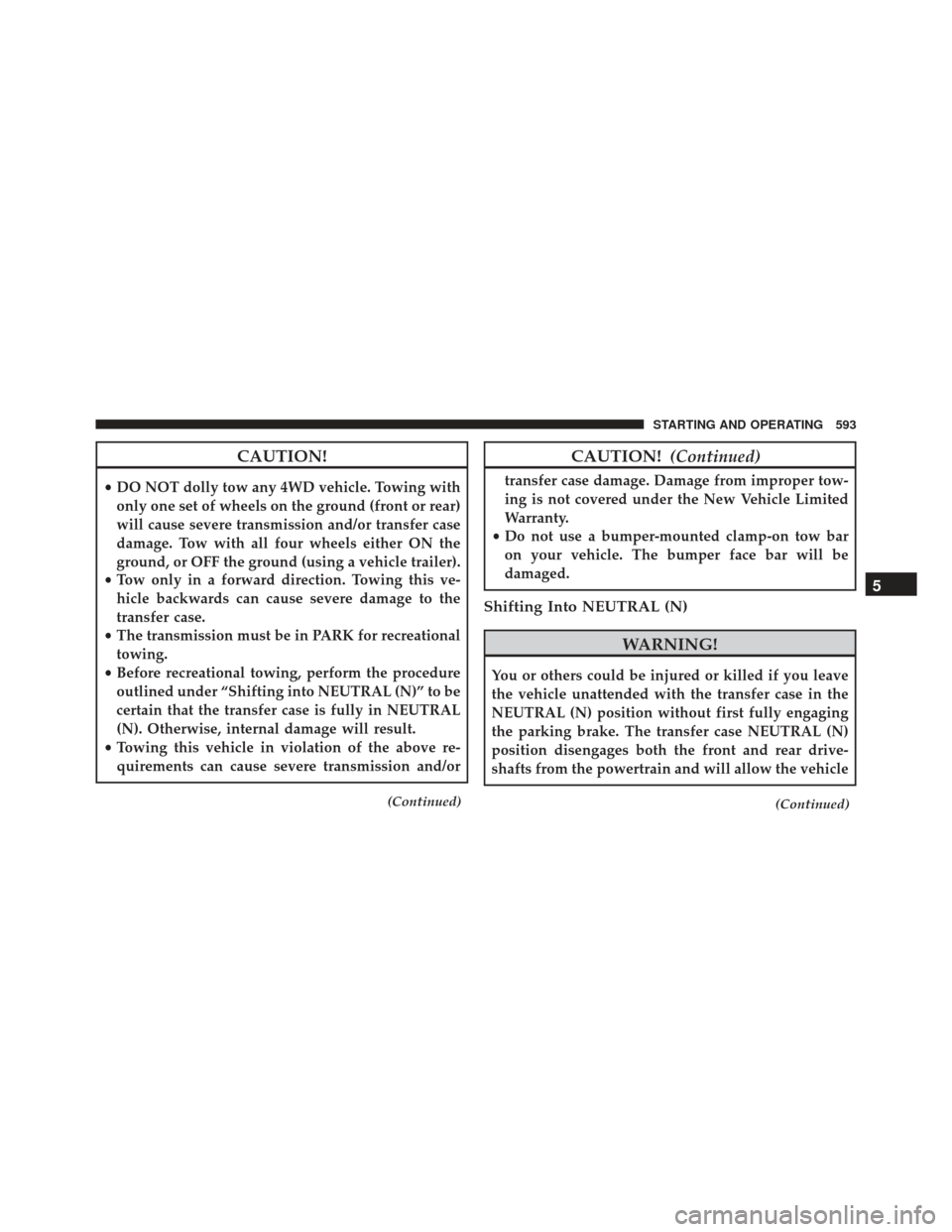Page 516 of 745

Disabling And Enabling HSA
This feature can be turned on or turned off. To change the
current setting, proceed as follows:
•For vehicles equipped with the Driver Information
Display (DID), refer to “Driver Information Display
(DID)” in “Understanding Your Instrument Panel” for
further information.
• If disabling HSA using Uconnect Settings, refer to
“Uconnect Settings” in “Understanding Your Instru-
ment Panel” for further information.
For vehicles not equipped with the DID, perform the
following steps:
1. Center the steering wheel (front wheels pointing straight forward).
2. Shift the transmission into PARK.
3. Apply the parking brake. 4. Start the engine.
5. Rotate the steering wheel slightly more than one-half
turn to the left.
6. Push the “ESC Off” button located in the lower switch bank below the climate control four times within
twenty seconds. The “ESC Off Indicator Light” should
turn on and turn off two times.
7. Rotate the steering wheel back to center and then an additional slighty more than one-half turn to the right.
8. Turn the ignition switch to the OFF position and then back to the ON position. If the sequence was com-
pleted properly, the “ESC Off Indicator Light” will
blink several times to confirm HSA is disabled.
9. Repeat these steps if you want to return this feature to its previous setting.
514 STARTING AND OPERATING
Page 561 of 745
Premium System
The Tire Pressure Monitor System (TPMS) uses wireless
technology with wheel rim-mounted electronic sensors to
monitor tire pressure levels. Sensors, mounted to each
wheel as part of the valve stem, transmit tire pressure
readings to the Receiver Module.NOTE:
It is particularly important, for you to regularly
check the tire pressure in all of your tires and to maintain
the proper pressure.
The Tire Pressure Monitor System (TPMS) consists of the
following components:
• Receiver Module
• Four Tire Pressure Monitoring Sensors
• Various Tire Pressure Monitoring System Messages,
which display in the Driver Information Display
(DID), and a graphic displaying tire pressures
• Tire Pressure Monitoring Telltale Light
Tire Pressure Monitor Display
5
STARTING AND OPERATING 559
Page 564 of 745

4. Using tire chains on the vehicle.
5. Using wheels/tires not equipped with TPM sensors.
NOTE:There is no tire pressure monitoring sensor in the
spare tire. The TPMS will not be able to monitor the tire
pressure. If you install the spare tire in place of a road tire
that has a pressure below the low-pressure warning limit,
upon the next ignition switch cycle, the Tire Pressure
Monitoring Telltale Light will remain ON, a chime will
sound, and the DID will still display a pressure value in
the different color graphic display and an �Inflate to XXX
kPa� message will be displayed. After driving the vehicle
for up to 20 minutes above 15 mph (24 km/h), the Tire
Pressure Monitoring Telltale Light will flash on and off
for 75 seconds and then remain on solid. In addition, the
DID will display a “SERVICE TPM SYSTEM� message for
five seconds and then display dashes (- -) in place of the pressure value. For each subsequent ignition switch
cycle, a chime will sound, the Tire Pressure Monitoring
Telltale Light will flash on and off for 75 seconds and then
remain on solid, and the DID will display a
�SERVICE
TPM SYSTEM� message for five seconds and then dis-
play dashes (- -) in place of the pressure value. Once you
repair or replace the original road tire, and reinstall it on
the vehicle in place of the spare tire, the TPMS will
update automatically.
In addition, the Tire Pressure Monitoring Telltale Light
will turn OFF and the graphic in the DID will display a
new pressure value instead of dashes (- -), as long as no
tire pressure is below the low-pressure warning limit in
any of the four active road tires. The vehicle may need to
be driven for up to 20 minutes above 15 mph (24 km/h)
in order for the TPMS to receive this information.
562 STARTING AND OPERATING
Page 586 of 745

WARNING!
Improper towing can lead to a collision. Follow these
guidelines to make your trailer towing as safe as
possible:
•Make certain that the load is secured in the trailer
and will not shift during travel. When trailering
cargo that is not fully secured, dynamic load shifts
can occur that may be difficult for the driver to
control. You could lose control of your vehicle and
have a collision.
• When hauling cargo or towing a trailer, do not
overload your vehicle or trailer. Overloading can
cause a loss of control, poor performance or dam-
age to brakes, axle, engine, transmission, steering,
suspension, chassis structure or tires.
• Safety chains must always be used between your
vehicle and trailer. Always connect the chains to
(Continued)
WARNING! (Continued)
the hook retainers of the vehicle hitch. Cross the
chains under the trailer tongue and allow enough
slack for turning corners.
• Vehicles with trailers should not be parked on a
grade. When parking, apply the parking brake on
the tow vehicle. Put the tow vehicle transmission in
PARK. For four-wheel drive vehicles, make sure
the transfer case is not in NEUTRAL. Always,
block or �chock�the trailer wheels.
• GCWR must not be exceeded.
• Total weight must be distributed between the tow
vehicle and the trailer such that the following four
ratings are not exceeded:
1. GVWR
2. GTW
(Continued)
584 STARTING AND OPERATING
Page 592 of 745
RECREATIONAL TOWING (BEHIND MOTORHOME, ETC.)
Towing This Vehicle Behind Another Vehicle
Towing ConditionWheels OFF the
Ground Two-Wheel Drive
Models Four-Wheel Drive
Models Without 4–LO Range Four-Wheel Drive
Models With 4–LO Range
Flat Tow NONE NOT ALLOWED NOT ALLOWED See Instructions
•Transmission in
PARK
•Transfer case in
NEUTRAL (N)
•Tow in forward
direction
Dolly Tow Front NOT ALLOWED NOT ALLOWED NOT ALLOWED
Rear OKNOT ALLOWED NOT ALLOWED
On Trailer ALLOKOK OK
590 STARTING AND OPERATING
Page 594 of 745

5. Properly secure the rear wheels to the dolly, followingthe dolly manufacturer ’s instructions.
6. Install a suitable clamping device, designed for tow- ing, to secure the front wheels in the straight position.
CAUTION!
Towing with the rear wheels on the ground will
cause severe transmission damage. Damage from
improper towing is not covered under the New
Vehicle Limited Warranty.
Recreational Towing — Quadra-Trac I
(Single-Speed Transfer Case) Four-Wheel Drive
Models
Recreational towing is not allowed. These models do
not have a NEUTRAL (N) position in the transfer case. NOTE:
This vehicle may be towed on a flatbed or vehicle
trailer provided all four wheels are OFFthe ground.
CAUTION!
Towing this vehicle in violation of the above require-
ments can cause severe transmission and/or transfer
case damage. Damage from improper towing is not
covered under the New Vehicle Limited Warranty.
Recreational Towing — Quadra–Trac II
/Quadra–Drive II Four-Wheel Drive Models
The transfer case must be shifted into NEUTRAL (N) and
the transmission must be in PARK for recreational tow-
ing. The NEUTRAL (N) selection button is adjacent to the
transfer case selector switch. Shifts into and out of
transfer case NEUTRAL (N) can take place with the
selector switch in any mode position.
592 STARTING AND OPERATING
Page 595 of 745

CAUTION!
•DO NOT dolly tow any 4WD vehicle. Towing with
only one set of wheels on the ground (front or rear)
will cause severe transmission and/or transfer case
damage. Tow with all four wheels either ON the
ground, or OFF the ground (using a vehicle trailer).
• Tow only in a forward direction. Towing this ve-
hicle backwards can cause severe damage to the
transfer case.
• The transmission must be in PARK for recreational
towing.
• Before recreational towing, perform the procedure
outlined under “Shifting into NEUTRAL (N)” to be
certain that the transfer case is fully in NEUTRAL
(N). Otherwise, internal damage will result.
• Towing this vehicle in violation of the above re-
quirements can cause severe transmission and/or
(Continued)
CAUTION! (Continued)
transfer case damage. Damage from improper tow-
ing is not covered under the New Vehicle Limited
Warranty.
• Do not use a bumper-mounted clamp-on tow bar
on your vehicle. The bumper face bar will be
damaged.
Shifting Into NEUTRAL (N)
WARNING!
You or others could be injured or killed if you leave
the vehicle unattended with the transfer case in the
NEUTRAL (N) position without first fully engaging
the parking brake. The transfer case NEUTRAL (N)
position disengages both the front and rear drive-
shafts from the powertrain and will allow the vehicle
(Continued)
5
STARTING AND OPERATING 593
Page 596 of 745

WARNING!(Continued)
to roll, even if the transmission is in PARK. The
parking brake should always be applied when the
driver is not in the vehicle.
Use the following procedure to prepare your vehicle for
recreational towing.
CAUTION!
It is necessary to follow these steps to be certain that
the transfer case is fully in NEUTRAL (N) before
recreational towing to prevent damage to internal
parts.
1. Bring the vehicle to a complete stop, with the engine running.
2. Press and hold the brake pedal. 3. Shift the transmission into NEUTRAL.
4. If vehicle is equipped with Quadra-Lift air suspension,
ensure the vehicle is set to Normal Ride Height.
5. Using a ballpoint pen or similar object, press and hold the recessed transfer case NEUTRAL (N) button (lo-
cated by the selector switch) for four seconds. The
light behind the N symbol will blink, indicating shift
in progress. The light will stop blinking (stay on solid)
when the shift to NEUTRAL (N) is complete. A “FOUR
WHEEL DRIVE SYSTEM IN NEUTRAL” message will
appear in the Driver Information Display (DID). Refer
to “Driver Information Display (DID)” in “Under-
standing Your Instrument Panel” for further informa-
tion.
594 STARTING AND OPERATING